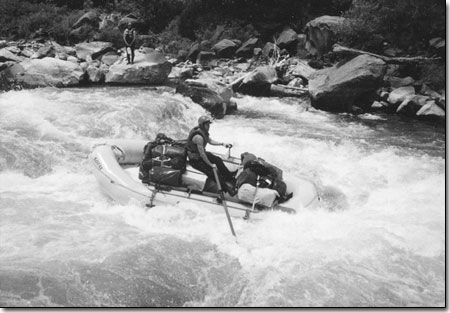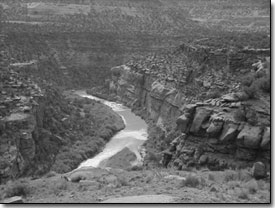|
Dolores River Dialogue searches for consensus
and flow
by Will Sands
 |
| An unidentified boater makes
a rare run of Snaggletooth on the lower Dolores in 1996. For
the most part, flows on the river have been little more than
a trickle since McPhee Reservoir was built in 1985. A broad-based
effort is currently looking for solutions that would add volume
and benefit native species, trout and recreation./Photo by
Mark Pearson |
Flows on one of the Southwest’s great rivers have been
stunted for the nearly 20 years since McPhee Reservoir’s
birth in 1985. While agriculture has been greatly enhanced because
of the reservoir, the character of the Dolores River has been
greatly impacted. This spring is no exception. Early this week,
the river above McPhee Reservoir was running at 2,260 cubic feet
per second, the highest level in recent memory. Below the dam,
a mere 40 cfs trickled down the Dolores.
However, this picture could come back into balance. A broad-based
effort is under way to send more water downstream. And in addition
to conservationists, ranchers, farmers and irrigators have taken
a seat at the table in an effort to help solve the dilemma.
The Dolores River Coalition officially launched in early June
of last year with a mission of protecting and enhancing the entire
Dolores River Basin. The coalition spans 21 different groups ranging
from Durango’s San Juan Citizens’ Alliance and locally-based
Great Old Broads for Wilderness to the Southern Utah Wilderness
Alliance, Environmental Defense Fund and Colorado Environmental
Coalition. While the group is working on issues throughout the
river basin, one of the first items on a long list is getting
more water to flow below McPhee Dam.
In this spirit, a series of talks kicked off shortly after the
formation of the Dolores River Coalition. Christened the Dolores
River Dialogue, the effort brought numerous stakeholders from
throughout the basin to the table. Beyond conservationists, agencies
like the Forest Service and Montezuma County are represented along
with entities associated with water development like the Montezuma
Valley Irrigators Association, the Dolores River Water Conservancy
District and the Bureau of Reclamation. Over the course of four
meetings, this diverse group has achieved one milestone —
agreement that more water needs to flow downstream of McPhee.
Over the next six meetings that are planned, they will try to
figure out how to make it happen.
Chuck Wanner, Dolores River Coalition coordinator, commented,
“We’re trying to decide how to meet three needs in
the lower river: maintaining the stream shape and the habitats
for the various native species; what’s needed for the cold
water trout fishery; and what’s needed for recreation.”
Wanner added that habitat and native species are definitely the
highest priority. “Success on this effort cannot be measured
by whether or not people can put on the river and float,”
he said. “It’s pretty complex, but I’m very
optimistic.”
John Porter is Wanner’s opposite in the Dolores River Dialogue.
While Wanner represents a conservation coalition, Porter is attending
on behalf of the Dolores Water Conservancy District, an entity
currently calling for a new reservoir in the basin. “I think
we’ve realized that the goals are the same,” Porter
said. “We want to get more water released downstream for
fish and wildlife habitat without harming present users.”
 |
The Dolores River winds its way through
the high desert of the West Slope. Members of the Dolores
River Dialogue are optimistic that their efforts will be
successful over the long term./Photo courtesy of USGS |
Mike Preston, of the Fort Lewis College Office of Community Services,
is moderating the Dolores River Dialogue. He concurred with Porter,
saying, “There seems to be an emerging consensus that the
priority is ending damage to native species and habitat.”
Porter and Preston also agreed that more water will require either
more storage or money to purchase water rights. Porter said that
when people think of enhancing the downstream flow of the Dolores,
new dams are not the first things that come to mind.
“The Dolores Water Conservancy District has always felt
that there is more water available in the basin,” Porter
said. “But that means more storage, and that has not been
an easy bridge for people who want more water downstream to cross.”
In fact, the Dolores Water Conservancy District is currently
pursuing a plan to build a new dam on Plateau Creek, a major tributary
of the Dolores. As stated, the district’s primary goal is
to maintain the current allocations for agriculture from McPhee
Reservoir, while satisfying demands for a more consistent water
release for the non-native recreational trout fishery. The new
reservoir would also help eliminate “spill,” another
term for spring run-off.
“We’ve looked at ways of managing the spill to better
benefit the fishery,” Porter said. “But without harming
some other user, it’s hard help.”
Wanner did not limit solutions to new storage or new water rights,
but he did say that the Dolores River Dialogue is currently looking
to hire technical expertise and an ability to look at facts rather
than concepts.
“At this point, we need some technical help in order to
come up with creative options,” he said. “Rather than
talk about pie in the sky or ‘would of, could of, should
of,’ we’re looking at hard facts.”
Porter did mention that this is the third effort of its kind.
But event with the other failures in mind, he said that he is
optimistic that flows can be increased on the lower Dolores.
“It’s hopeful that the participants in this current
effort can collaborate and eventually reach consensus,”
he said. “At this point, I don’t have any predictions,
but as long as people are still talking, there’s hope for
finding some new solutions.”
As the facilitator of the process, Preston shared this optimism
and he noted that people are definitely still talking. “People
are still suspending judgment on the outcome, but the process
is moving forward,” he said. “We’ve had a pretty
full table at every meeting.”
Wanner agreed that whether a long-term fix for the flow below
McPhee can be found hinges on the people sitting at the table.
“This process will either succeed or end, and it will end
if a significant number of participants feel like we’re
not making significant progress,” he said.
Like Preston and Porter, Wanner has hope, but given the complexity
of the issue, he also has patience.
“I have faith in people’s abilities to work things
out over time, and this is the kind of solution that we have to
figure out,” Wanner said in closing. “There aren’t
any silver bullet answers to make this thing work.”
|

